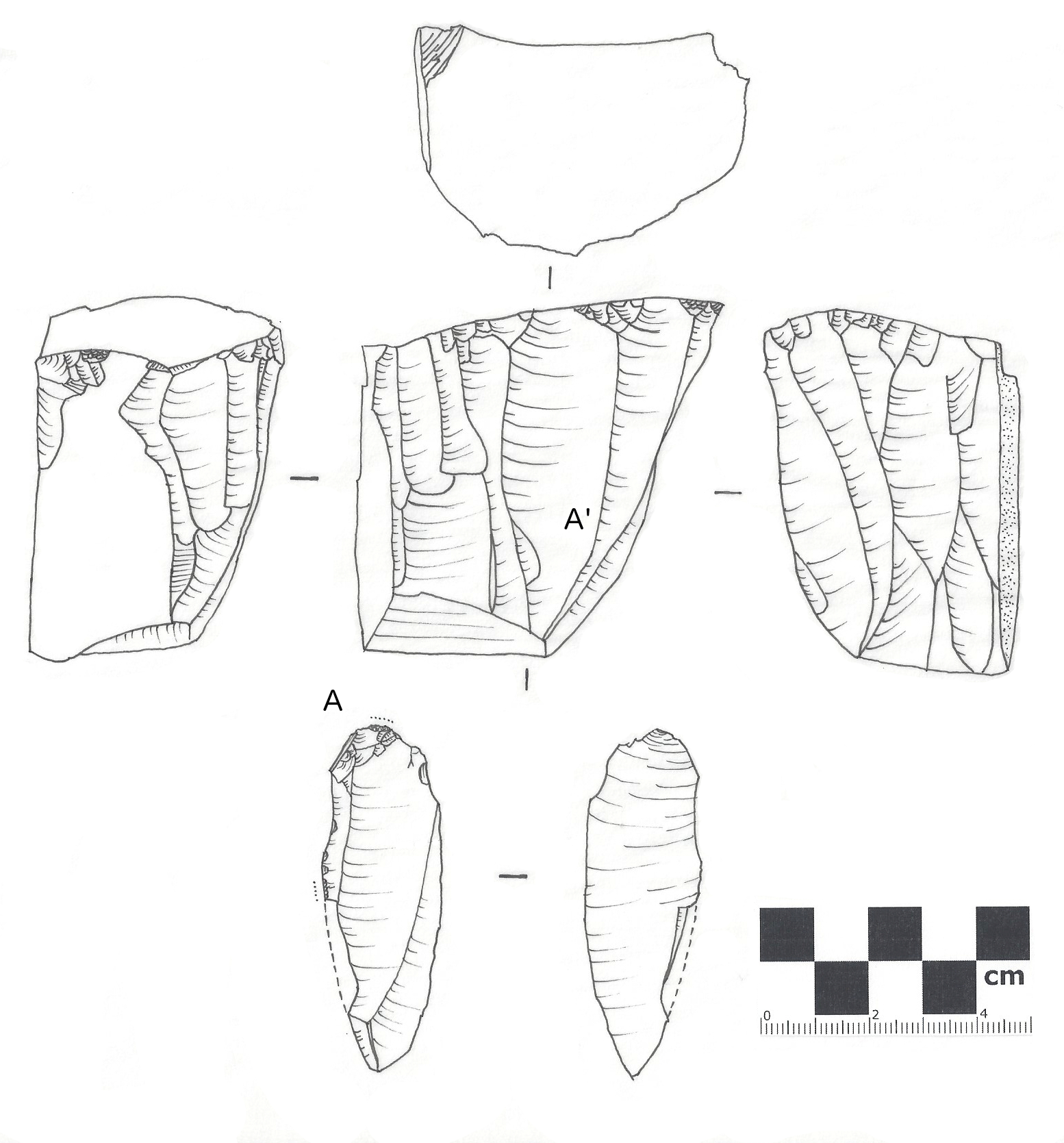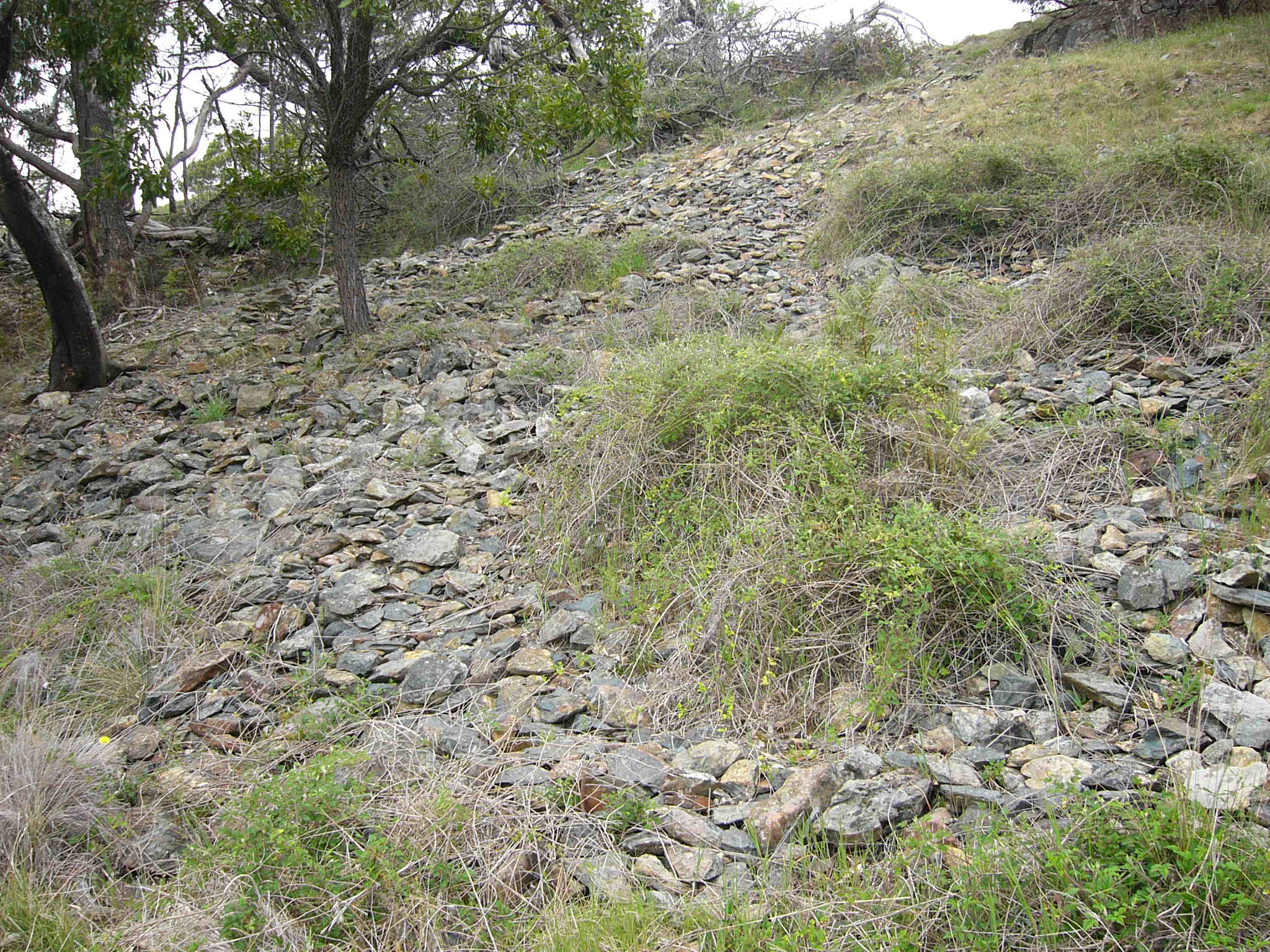|
Eraillure
In lithic analysis (a subdivision of archaeology), an eraillure is a flake removed from a lithic flake's bulb of force, which is a lump left on the ventral surface of a flake after it is detached from a core of tool stone during the process of lithic reduction.Hiscock, Peter. (1997Glossary of Terms used in "Lithic" Analysis." Australian National University. Retrieved 2011-12-14. The mechanics of eraillure formation are related to the propagation of a Hertzian cone of force through the cryptocrystalline matrix of the stone, but the particulars are poorly understood. Eraillures usually form only when a hammerstone is used for lithic reduction, and then only occasionally; use of 'soft' hammer fabricators made from bone, antler, and wood produce different flake characteristics but may also produce an eraillure in rare cases. See also * Stone tool Stone tools have been used throughout human history but are most closely associated with prehistoric cultures and in particular t ... [...More Info...] [...Related Items...] OR: [Wikipedia] [Google] [Baidu] |
Lithic Flake
In archaeology, a lithic flake is a "portion of rock (geology), rock removed from an objective piece by percussion or pressure,"Andrefsky, W. (2005) ''Lithics: Macroscopic Approaches to Analysis''. 2d Ed. Cambridge, Cambridge University Press and may also be referred to as simply a ''flake'', or collectively as debitage. The objective piece, or the rock being reduced by the removal of flakes, is known as a lithic core, core.Andrefsky, W. (2005) ''Lithics: Macroscopic Approaches to Analysis''. 2d Ed. Cambridge, Cambridge University Press Once the proper tool stone has been selected, a percussor or pressure flaker (e.g., an antler Tine (structural), tine) is used to direct a sharp blow, or apply sufficient force, respectively, to the surface of the stone, often on the edge of the piece. The energy of this blow propagates through the material, often (termination type, but not always) producing a Hertzian cone of force which causes the rock to fracture in a controllable fashion. Since c ... [...More Info...] [...Related Items...] OR: [Wikipedia] [Google] [Baidu] |
Lithic Analysis
In archaeology, lithic analysis is the analysis of stone tools and other chipped stone artifacts using basic scientific techniques. At its most basic level, lithic analyses involve an analysis of the artifact's morphology, the measurement of various physical attributes, and examining other visible features (such as noting the presence or absence of cortex, for example). The term 'lithic analysis' can technically refer to the study of any anthropogenic (human-created) stone, but in its usual sense it is applied to archaeological material that was produced through lithic reduction (knapping) or ground stone. A thorough understanding of the lithic reduction and ground stone processes, in combination with the use of statistics, can allow the analyst to draw conclusions concerning the type of lithic manufacturing techniques used at a prehistoric archaeological site. For example, they can make certain equation between each the factors of flake to predict original shape. These data ... [...More Info...] [...Related Items...] OR: [Wikipedia] [Google] [Baidu] |
Archaeology
Archaeology or archeology is the study of human activity through the recovery and analysis of material culture. The archaeological record consists of Artifact (archaeology), artifacts, architecture, biofact (archaeology), biofacts or ecofacts, archaeological site, sites, and cultural landscapes. Archaeology can be considered both a social science and a branch of the humanities. It is usually considered an independent academic discipline, but may also be classified as part of anthropology (in North America – the four-field approach), history or geography. The discipline involves Survey (archaeology), surveying, Archaeological excavation, excavation, and eventually Post excavation, analysis of data collected, to learn more about the past. In broad scope, archaeology relies on cross-disciplinary research. Archaeologists study human prehistory and history, from the development of the first stone tools at Lomekwi in East Africa 3.3 million years ago up until recent decades. A ... [...More Info...] [...Related Items...] OR: [Wikipedia] [Google] [Baidu] |
Bulb Of Applied Force
In lithic analysis, a subdivision of archaeology, a bulb of applied force (also known as a bulb of percussion or simply bulb of force) is a defining characteristic of a lithic flake. Bulb of applied force was first correctly described by Sir John Evans, the cofounder of prehistoric archeology. However, bulb of percussion was coined scientifically by W.J. Sollas. When a flake is detached from its parent core, a portion of the Hertzian cone of force caused by the detachment blow is detached with it, leaving a distinctive bulb on the flake and a corresponding flake scar on the core. In the case of a unidirectional core, the bulb of applied force is produced by an initiated crack formed at the point of contact, which begins making the Hertzian cone. The outward pressure increases causing the crack to curve away from the core and the bulb formation. The bulb of applied force forms below the striking platform as a slight bulge. If the flake is completely crushed, the bulb will not be vis ... [...More Info...] [...Related Items...] OR: [Wikipedia] [Google] [Baidu] |
Tool Stone
In archaeology, a tool stone is a type of stone that is used to manufacture stone tools, or tools that use stone as raw material. Generally speaking, tools that require a sharp edge are made using cryptocrystalline materials that fracture in an easily controlled conchoidal manner. Cryptocrystalline tool stones include flint and chert, which are fine-grained sedimentary materials; rhyolite and felsite, which are igneous flowstones; and obsidian, a form of natural glass created by igneous processes. These materials fracture in a predictable fashion, and are easily resharpened. For more information on this subject, see lithic reduction. Large-grained materials such as basalt, granite and sandstone may also be used as tool stones, but for a very different purpose: they are ideal for ground stone artifacts. Whereas cryptocrystalline materials are most useful for killing and processing animals, large-grained materials are usually used for processing plant matter. Their roug ... [...More Info...] [...Related Items...] OR: [Wikipedia] [Google] [Baidu] |
Lithic Reduction
In archaeology, in particular of the Stone Age, lithic reduction is the process of fashioning stones or rocks from their natural state into tools or weapons by removing some parts. It has been intensely studied and many archaeological industries are identified almost entirely by the lithic analysis of the precise style of their tools and the chaîne opératoire of the reduction techniques they used. Normally the starting point is the selection of a piece of tool stone that has been detached by natural geological processes, and is an appropriate size and shape. In some cases solid rock or larger boulders may be quarried and broken into suitable smaller pieces, and in others the starting point may be a piece of the debitage, a flake removed from a previous operation to make a larger tool. The selected piece is called the lithic core (also known as the "objective piece"). A basic distinction is that between flaked or knapped stone, the main subject here, and ground stone ... [...More Info...] [...Related Items...] OR: [Wikipedia] [Google] [Baidu] |
Hertzian Cone
A Hertzian cone is the cone produced when an object passes through a solid, such as a bullet through glass. More technically, it is a cone of force that propagates through a brittle, amorphous, or cryptocrystalline solid material from a point of impact. This force eventually removes a full or partial cone in the material. This is the physical principle that explains the form and characteristics of the flakes removed from a core of tool stone during the process of lithic reduction. This phenomenon is named after the German physicist Heinrich Rudolf Hertz, who first described this type of wave-front propagation through various media. Although it might not be agreed by all, natural phenomena which have been grouped with the Hertzian cone phenomena include the crescentic " chatter marks" made on smoothed bedrock by glacial ice dragging along boulders at its base, the numerous crescentic impact marks sometimes seen on pebbles and cobbles, and the shatter cones found at bolide imp ... [...More Info...] [...Related Items...] OR: [Wikipedia] [Google] [Baidu] |
Cryptocrystal
Cryptocrystalline is a rock texture made up of such minute crystals that its crystalline nature is only vaguely revealed even microscopically in thin section by transmitted polarized light. Among the sedimentary rocks, chert and flint are cryptocrystalline. Carbonado, a form of diamond, is also cryptocrystalline. Volcanic rocks, especially of the felsic type such as felsites and rhyolites, may have a cryptocrystalline groundmass as distinguished from pure obsidian (felsic) or tachylyte (mafic), which are natural rock glasses. Agate and onyx are examples of cryptocrystalline silica (chalcedony). The quartz crystals in chalcedony are so tiny that they cannot be distinguished with the naked eye. See also * List of rock textures * Macrocrystalline * Microcrystalline * Nanocrystalline * Rock microstructure Rock most often refers to: * Rock (geology), a naturally occurring solid aggregate of minerals or mineraloids * Rock music, a genre of popular music Rock or Rocks may also ... [...More Info...] [...Related Items...] OR: [Wikipedia] [Google] [Baidu] |
Hammerstone
In archaeology, a hammerstone is a hard cobble used to strike off lithic flakes from a lump of tool stone during the process of lithic reduction. The hammerstone is a rather universal stone tool which appeared early in most regions of the world including Europe, India and North America. This technology was of major importance to prehistoric cultures before the development of metalworking. Materials A hammerstone is made of a material such as sandstone, limestone or quartzite, is often ovoid in shape (to fit the human hand better), and develops telltale battering marks on one or both ends. In archaeological recovery, hammerstones are often found in association with other stone tool artifacts, debitage and/or objects of the hammer such as ore. The modern use of hammerstones is now mostly limited to flintknappers and others who wish to develop a better understanding of how stone tools were made. Usage Hammerstones are or were used to produce flakes and hand axes as well a ... [...More Info...] [...Related Items...] OR: [Wikipedia] [Google] [Baidu] |
Bone
A bone is a rigid organ that constitutes part of the skeleton in most vertebrate animals. Bones protect the various other organs of the body, produce red and white blood cells, store minerals, provide structure and support for the body, and enable mobility. Bones come in a variety of shapes and sizes and have complex internal and external structures. They are lightweight yet strong and hard and serve multiple functions. Bone tissue (osseous tissue), which is also called bone in the uncountable sense of that word, is hard tissue, a type of specialised connective tissue. It has a honeycomb-like matrix internally, which helps to give the bone rigidity. Bone tissue is made up of different types of bone cells. Osteoblasts and osteocytes are involved in the formation and mineralisation of bone; osteoclasts are involved in the resorption of bone tissue. Modified (flattened) osteoblasts become the lining cells that form a protective layer on the bone surface. The mine ... [...More Info...] [...Related Items...] OR: [Wikipedia] [Google] [Baidu] |
Antler
Antlers are extensions of an animal's skull found in members of the Cervidae (deer) Family (biology), family. Antlers are a single structure composed of bone, cartilage, fibrous tissue, skin, nerves, and blood vessels. They are generally found only on males, with the exception of Reindeer, reindeer/caribou. Antlers are Moulting, shed and regrown each year and function primarily as objects of sexual attraction and as Weapon (biology), weapons. Etymology Antler comes from the Old French ''antoillier ''(see present French : "Andouiller", from'' ant-, ''meaning before,'' oeil, ''meaning eye and'' -ier'', a suffix indicating an action or state of being) possibly from some form of an unattested Latin word ''*anteocularis'', "before the eye" (and applied to the word for "branch" or "horn (anatomy), horn"). Structure and development Antlers are unique to cervids. The ancestors of deer had tusks (long upper canine tooth, canine teeth). In most species, antlers appear to replace t ... [...More Info...] [...Related Items...] OR: [Wikipedia] [Google] [Baidu] |
Wood
Wood is a structural tissue/material found as xylem in the stems and roots of trees and other woody plants. It is an organic materiala natural composite of cellulosic fibers that are strong in tension and embedded in a matrix of lignin that resists compression. Wood is sometimes defined as only the secondary xylem in the stems of trees, or more broadly to include the same type of tissue elsewhere, such as in the roots of trees or shrubs. In a living tree, it performs a mechanical-support function, enabling woody plants to grow large or to stand up by themselves. It also conveys water and nutrients among the leaves, other growing tissues, and the roots. Wood may also refer to other plant materials with comparable properties, and to material engineered from wood, woodchips, or fibers. Wood has been used for thousands of years for fuel, as a construction material, for making tools and weapons, furniture and paper. More recently it emerged as a feedstock for the production ... [...More Info...] [...Related Items...] OR: [Wikipedia] [Google] [Baidu] |





